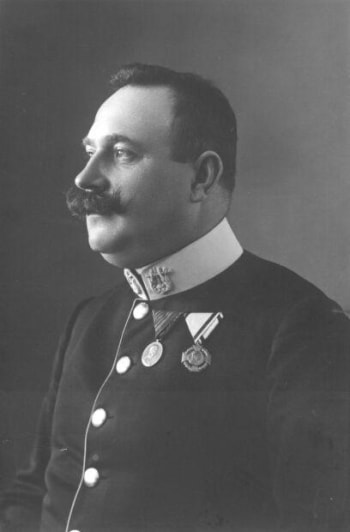
This Media Center item can only be displayed if you agree to the use of marketing cookies. With one click you can accept it.
Husarenvedette
Info
Notes available at:
https://www.rundel.de/en/
Vedette of Hussars
Marsch / March / Marche / op. 236
The march "Husarenvedette" (“Hussar Vedette”) was created in Budapest in 1910. In May 1909 Fucík had given his last concert as regiment bandmaster of the Infantry Regiment 86 in Budapest. Less pleasing for him was the subsequent transfer of the regiment to Maria Theresiopel (today Subotica, Serbia). For him, this military measure resulted in professional descent. He therefore took his leave of the regiment in January 1910 and temporarily moved to Gleisdorf in Styria. Even the following time at IR 92 in Theresienstadt did not prove to be the hoped-for stroke of luck after his successful time in Budapest, as his colleagues in Prague managed to keep Julius Fucík and his Banda away from Bohemia's capital.
Julius Fucík spent the last part of his life in Berlin, where he founded his own publishing house and developed an interesting concert activity with the Prague Tonkünstler Orchestra. The swinging march called “Husarenvedette” was included in a remarkable double concert on 13 April 1914, which the maestro and his Prague musicians performed with the music corps of the Emperor Franz Gardegrenadier Regiment No. 2 conducted by Chief Music Master Adolf Becker. Strictly interpreted, the march is not a cavalry march, because since the lost war of 1866, no cavalry music was known in the joint kingdom of Austria and Hungary. It was different in Germany, where the image of cavalry music was determined by countless trumpet corps in cavalry and field artillery. The term "vedette" is a military term that is no longer in use today. It refers to the use of mounted soldiers to observe the enemy in front of the army's field posts. Accordingly, this march from Fucík is more a musical impression than a cavalry march. In contrast to many of Fucík’s massive marches, this is a fresh, elegant and basically not very military march, which became popular in Germany faster than in Fucíks Bohemian homeland or the Danube Monarchy as a whole.
Please visit the website of RUNDEL Julius-Fucík-Edition
www.juliusfucik.de
Grade Level GB: 3-4
Grade Level USA: 2+ (Easy-Medium)
Composer: Fucik, Julius
Arranger: Zeman, Jaroslav
Genre: Concert March, March
Performance time: 3,00
Publisher: Rundel
Size: DIN A4
Info: Full Score + Condensed Score + Parts
Rundel Order Number: MVSR3457
Release Date: 2020
https://www.rundel.de/en/
Vedette of Hussars
Marsch / March / Marche / op. 236
The march "Husarenvedette" (“Hussar Vedette”) was created in Budapest in 1910. In May 1909 Fucík had given his last concert as regiment bandmaster of the Infantry Regiment 86 in Budapest. Less pleasing for him was the subsequent transfer of the regiment to Maria Theresiopel (today Subotica, Serbia). For him, this military measure resulted in professional descent. He therefore took his leave of the regiment in January 1910 and temporarily moved to Gleisdorf in Styria. Even the following time at IR 92 in Theresienstadt did not prove to be the hoped-for stroke of luck after his successful time in Budapest, as his colleagues in Prague managed to keep Julius Fucík and his Banda away from Bohemia's capital.
Julius Fucík spent the last part of his life in Berlin, where he founded his own publishing house and developed an interesting concert activity with the Prague Tonkünstler Orchestra. The swinging march called “Husarenvedette” was included in a remarkable double concert on 13 April 1914, which the maestro and his Prague musicians performed with the music corps of the Emperor Franz Gardegrenadier Regiment No. 2 conducted by Chief Music Master Adolf Becker. Strictly interpreted, the march is not a cavalry march, because since the lost war of 1866, no cavalry music was known in the joint kingdom of Austria and Hungary. It was different in Germany, where the image of cavalry music was determined by countless trumpet corps in cavalry and field artillery. The term "vedette" is a military term that is no longer in use today. It refers to the use of mounted soldiers to observe the enemy in front of the army's field posts. Accordingly, this march from Fucík is more a musical impression than a cavalry march. In contrast to many of Fucík’s massive marches, this is a fresh, elegant and basically not very military march, which became popular in Germany faster than in Fucíks Bohemian homeland or the Danube Monarchy as a whole.
Please visit the website of RUNDEL Julius-Fucík-Edition
www.juliusfucik.de
Grade Level GB: 3-4
Grade Level USA: 2+ (Easy-Medium)
Composer: Fucik, Julius
Arranger: Zeman, Jaroslav
Genre: Concert March, March
Performance time: 3,00
Publisher: Rundel
Size: DIN A4
Info: Full Score + Condensed Score + Parts
Rundel Order Number: MVSR3457
Release Date: 2020
Recommended Articles
Husarenvedette
The march "Husarenvedette" (“Hussar Vedette”) was created in Budapest in 1910. In May 1909 Fučík had given his last concert as regiment bandmaster of the Infantry...Concert Band
MVSR3457
Recommended Persons
Julius Fucik (Fučík)
* 18.07.1872† 25.09.1916
World-renowned march composer Julius Fučík was born in Prague in 1872. An authentic and versatile Bohemian musician, Fučík attended the conservatory in his hometown for violin and bassoon. In 1891 he studied composition with Antonín Dvořák. Fučík played bassoon in several symphony and theatre orchestras. As common in Austria of that time, he had to prove himself...Info
Jaroslav Zeman
* 06.04.1936† 23.09.2022
Jaroslav Zeman was born in 1936 in Horní Chvatliny (District of Kolín). His father was a band master and his first musical educator. Jaroslav Zeman studied trombone and euphonium and became musician in the military bands in Prague and Písek. After studies of conducting at the State Conservatory in Prague, he was leader of the Pisek Military Music, the Czech Army Central Band,...Info
Media center
RUNDEL VIDEO
Attila
Notes available at:
https://www.rundel.de/en/
Marche hongroise triomphale op. 211
World-renowned march composer Julius Fucík was...
https://www.rundel.de/en/
Marche hongroise triomphale op. 211
World-renowned march composer Julius Fucík was...
RUNDEL VIDEO
Uncle Teddy
Notes available at:
https://www.rundel.de/en/
Marsch / March / Marche op. 239
The origin of the march “Uncle Teddy” goes...
https://www.rundel.de/en/
Marsch / March / Marche op. 239
The origin of the march “Uncle Teddy” goes...



